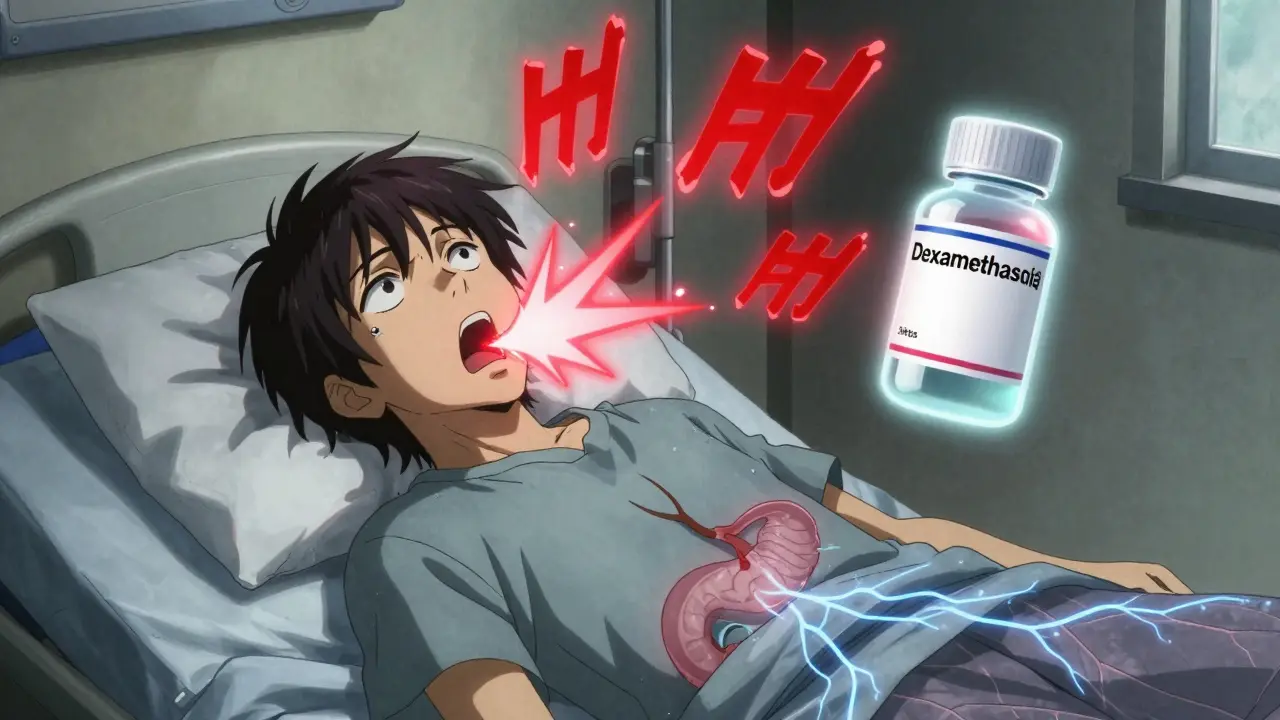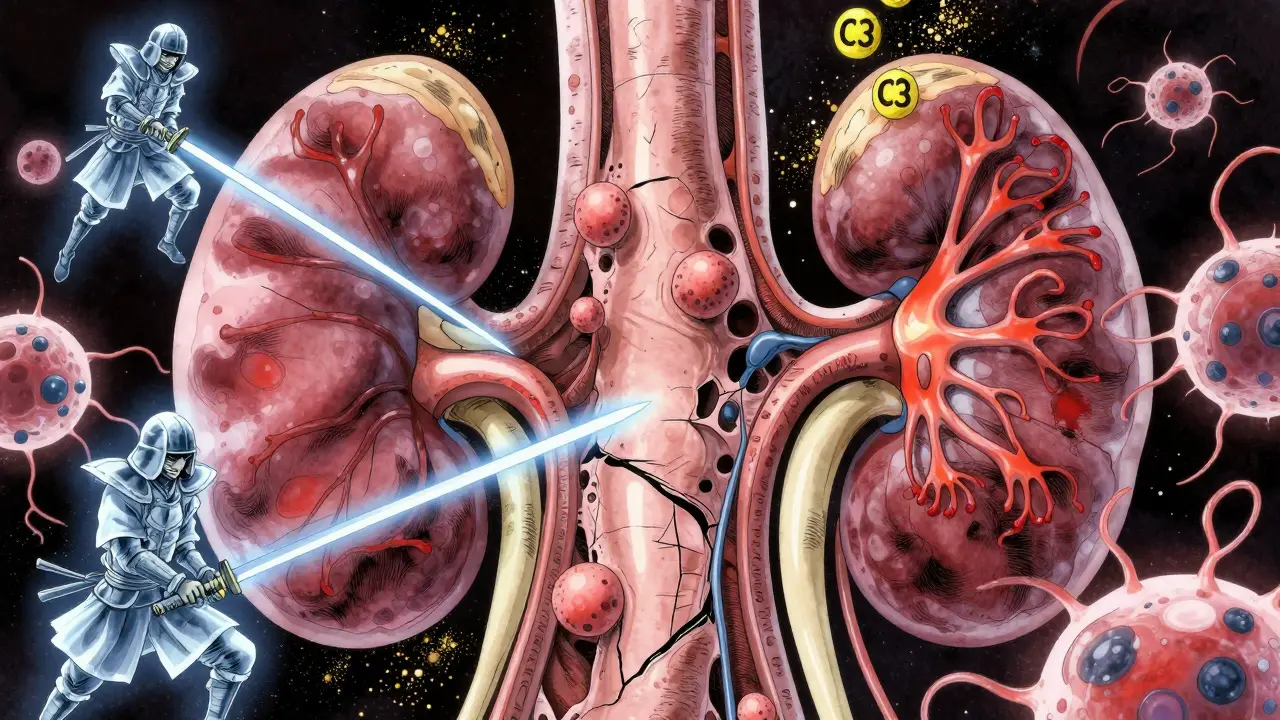Understanding the Different Types of Porphyria and Their Symptoms

Porphyria is a rare group of disorders that stems from problems with the way your body produces heme, which is crucial for oxygen transport and energy production in the cells. These conditions can be complex, but understanding the different types and their symptoms can help in managing and recognizing them.
Porphyrias are generally categorized into two main types: acute and cutaneous. Each type has its unique set of symptoms and triggers, making it crucial for anyone affected to learn about these conditions in-depth.
In this article, we'll journey through the types of porphyria and their symptoms, explore how they are diagnosed, and share some tips for managing the symptoms effectively.
- What is Porphyria?
- Acute Porphyrias
- Cutaneous Porphyrias
- Diagnosing Porphyria
- Managing Porphyria Symptoms
What is Porphyria?
Porphyria is a term that encompasses a group of rare, inherited disorders that result from gene mutations affecting the production of heme. Heme is a vital component in the body, crucial for forming hemoglobin, which carries oxygen in the blood. Individuals with porphyria have a defect in one of the enzymes involved in the heme production process, leading to a buildup of specific chemicals known as porphyrins and porphyrin precursors, which can cause a variety of symptoms.
Depending on the enzyme affected and where the chemical buildup occurs, porphyrias are generally classified into two main categories: acute porphyrias and cutaneous porphyrias. Acute porphyrias primarily affect the nervous system, causing symptoms like severe abdominal pain, vomiting, and neuropathy. On the other hand, cutaneous porphyrias manifest through skin-related symptoms, including blistering, itching, and swelling, after sun exposure.
The mutations that cause porphyria are usually inherited in an autosomal dominant pattern, meaning you only need one mutated gene from one parent to develop the disorder. However, some forms of porphyria may be autosomal recessive, requiring two copies of the mutated gene. Each type of porphyria is linked to a deficiency in a specific enzyme in the heme production pathway, leading to a distinctive set of symptoms and complications.
An interesting aspect of porphyria is its historical context. Some researchers believe that certain historical figures, such as King George III of Britain, may have had porphyria. This assumption is based on documented symptoms that align with what we now understand as this condition. Additionally, the so-called “vampire disease” theory suggests that the photosensitivity and skin symptoms of porphyria could have inspired legends about vampires.
The term “porphyria” itself is derived from the Greek word porphyra, meaning purple, because the disorder can cause a reddish-purple discoloration of urine during some types of attacks. Symptoms can range from mild to severe and may be triggered by specific factors, such as certain medications, alcohol use, fasting, or hormonal changes.
"Porphyrias are crucial in teaching us about the delicate balance needed in our biochemical pathways. Disruptions, even in small pieces of these pathways, can lead to significant and varied health issues," - Dr. Mary Smith, Geneticist.
Acute Porphyrias
Acute porphyrias are a subset of porphyrias characterized by sudden and severe symptoms, often affecting the nervous system. Typically, these symptoms can be triggered by certain medications, hormonal changes, fasting, or stress. Recognizing and understanding these triggers are crucial for managing the condition effectively.
The acute types include Acute Intermittent Porphyria (AIP), Variegate Porphyria (VP), Hereditary Coproporphyria (HCP), and ALAD Deficiency Porphyria (ADP). Each of these types has unique traits but often share common symptoms. These can include severe abdominal pain, vomiting, high blood pressure, rapid heart rate, seizures, and mental changes such as anxiety, confusion, or hallucinations. In some cases, these symptoms can escalate, leading to hospitalization.
A distinguishing feature of Acute Intermittent Porphyria is the presence of severe abdominal pain that does not show any clear physical cause upon examination. This pain can sometimes be accompanied by dark reddish urine, which is a tell-tale sign of porphyria. Neurological symptoms like muscle weakness or numbness are frequent in AIP attacks.
Triggers and Management
One of the common challenges with acute porphyrias is the identification of triggers that can initiate an attack. Certain medications, particularly those affecting the nervous system, can be dangerous for individuals with these conditions. Stress, both physical and emotional, can also play a significant role in triggering symptoms. Even lifestyle factors, such as fasting or extreme dieting, can cause an attack due to the sudden changes in nutrient levels. Maintaining a healthy and balanced diet is critical for minimizing these risks.
Managing acute porphyrias effectively involves both preventive and reactive measures. Preventive measures mean avoiding known triggers, keeping stress levels in check, and maintaining a nutrient-rich diet. In a reactive scenario, quick response to symptoms is crucial. Hospitalization might be necessary in severe cases, where treatments like glucose infusions or intravenous heme administration can be used to mitigate symptoms.
"Recognizing the early symptoms and triggers of acute porphyrias can make a massive difference in managing the condition effectively," says Dr. John Warner, a specialist in genetic metabolic disorders.
In terms of diagnosis, acute porphyrias can be challenging to identify due to their rarity and the similarity of their symptoms to other conditions. Medical history, combined with specific biochemical tests that measure porphyrin levels in urine, blood, and stool, plays a significant role in confirming the diagnosis. Genetic testing can also be useful, especially for relatives who might be at risk.
While acute porphyrias can be daunting, knowledge and preparedness can make a significant difference. Understanding the triggers, keeping an eye on possible symptoms, and working closely with healthcare providers are crucial steps in managing this condition effectively.
Cutaneous Porphyrias
Cutaneous porphyrias primarily affect the skin and are triggered by exposure to sunlight. When a person with cutaneous porphyria goes out into the sun, they may experience itching, blistering, and swelling of the skin. This happens because the compounds that build up in the skin absorb sunlight and become toxic, leading to these painful reactions.
One of the most common forms of cutaneous porphyria is Porphyria Cutanea Tarda (PCT). PCT usually develops in adults and can be triggered by various factors, such as alcohol consumption, smoking, or even certain medications. It is often characterized by extreme sensitivity to sunlight, leading to blistering on exposed areas of the skin, such as the hands and face.
Another type is Erythropoietic Protoporphyria (EPP), which often shows symptoms early in childhood. Children with EPP may refuse to go out into the sun because of the pain and skin damage that occur within minutes of exposure. Signs include redness, itching, and swelling, which can be severe and lead to long-term skin changes.
“Recognizing the symptoms early and taking preventive measures can greatly improve the quality of life for people with cutaneous porphyrias,” says Dr. Anne Carter, a dermatologist specializing in rare skin disorders.
Less commonly, inherited forms such as Congenital Erythropoietic Porphyria (CEP), also known as Gunther’s disease, can manifest. This type shows severe sensitivity to sunlight, resulting in blistering and scarring. Individuals with CEP often have reddish-brown teeth and increased hair growth, particularly on the face and hands.
Management of cutaneous porphyrias involves reducing exposure to sunlight and protecting the skin when outside. Sunscreens that block both UVA and UVB radiation are essential. Long-sleeved clothing, wide-brimmed hats, and sunglasses can add an extra layer of protection. For some individuals, avoiding triggers like alcohol and certain drugs that can exacerbate the condition is also crucial.
It's important to have a tailored approach under guidance from a healthcare provider. Some treatments, like phlebotomy (periodic blood removal), can help in cases like PCT by reducing the iron levels in the body. Low-dose chloroquine or hydroxychloroquine are sometimes used to decrease porphyrin levels as they can aid in excreting excess porphyrins from the liver.
Living with cutaneous porphyrias can be challenging, but with the right knowledge and precautions, individuals can better manage their condition and enjoy a higher quality of life. Staying informed about the latest research and treatment options can be immensely beneficial. Remember, each case is unique, so it’s important for those affected to work closely with healthcare professionals to develop an effective management plan.
Diagnosing Porphyria
Diagnosing porphyria can be a complex process due to the rarity and varied symptoms of the disorders. It often begins with a thorough medical history and physical examination, where a healthcare provider will look for characteristic signs and ask about your symptoms. From there, specific tests can narrow down whether porphyria is the culprit.
One of the primary diagnostic tools for porphyria is a series of biochemical tests. These tests typically involve analyzing samples of blood, urine, and stool. High levels of certain porphyrins or their precursors in these samples can indicate the presence of porphyria. For instance, elevated urine porphobilinogen is a clear marker for acute intermittent porphyria, while increased fecal coproporphyrins may indicate variegate porphyria.
“Accurate diagnosis is crucial as treatment for porphyria can vary significantly depending on the type,” says Dr. John Phillips, a leading expert in metabolic disorders.
Genetic testing is another vital step in diagnosing porphyria. This involves analyzing DNA to identify mutations in genes associated with the disorder. Since porphyria is often inherited, a positive genetic test can confirm the diagnosis and sometimes even predict which type of porphyria might develop in the future.
In some cases, a provocation test might be used. This test involves administering a drug that can trigger symptoms of porphyria in a controlled setting, helping to confirm a diagnosis. However, because this can induce a severe attack, such tests are used with caution and usually only in specific circumstances where other tests have been inconclusive.
Symptoms of porphyria may overlap with more common conditions, which can make diagnosis particularly challenging. For example, abdominal pain is a common symptom of many gastrointestinal disorders but is also prevalent in acute porphyria. This overlap requires healthcare professionals to be meticulous to avoid misdiagnosis.
Imaging studies, like X-rays or MRIs, may be employed to rule out other conditions and assess any organ damage caused by recurrent porphyria attacks. For example, these tests can help detect nerve damage or liver abnormalities, which are potential complications of certain porphyria types.
Early and accurate diagnosis is vital for managing porphyria effectively and minimizing the risk of long-term complications. If you or someone you know is experiencing unexplained symptoms that could be related to porphyria, consulting a specialist with experience in metabolic disorders may be a crucial step towards a definitive diagnosis and effective treatment plan.
Managing Porphyria Symptoms
Managing the symptoms of porphyria can feel like a balancing act. Knowing what triggers your symptoms and how to address them is crucial. One key approach is to identify and avoid triggers. For many, this could mean avoiding certain medications, alcohol, smoking, or stress, which can precipitate an acute attack. It’s vital for individuals with porphyria to maintain an updated list of safe medications and discuss any new prescriptions with a healthcare provider.
Diet also plays a significant role in managing porphyria symptoms. A high-carbohydrate diet may be beneficial, especially during an attack. Consuming carbohydrates can help suppress the production of porphyrins, the substances that build up due to the enzyme deficiencies causing the disorder. This means incorporating foods like bread, fruits, and pasta into your daily meals.
Another critical element is sunlight exposure. For those with cutaneous forms of porphyria, sunlight can cause severe skin reactions such as blistering, swelling, and itching. Wearing protective clothing, using high-SPF sunscreens (ideally SPF 50 or higher), and avoiding direct sunlight during peak hours can help mitigate these effects. Some patients have found relief using beta-carotene supplements, which can increase the skin’s tolerance to sunlight.
Emotional and psychological support cannot be overlooked. Living with a chronic condition like porphyria can be stressful and emotionally taxing. Seeking support from friends, family, or joining a support group can be invaluable. In a 2023 study, patients who participated in support groups reported a higher quality of life and better symptom management.
"The support and understanding from others who share your experiences can provide comfort and practical advice that healthcare professionals might not be able to offer," said Dr. Alice Thompson, a leading researcher in rare genetic disorders.
Regular medical follow-ups are essential. These help monitor the condition and catch any complications early. Keeping a detailed diary of symptoms, triggers, and treatments can be beneficial during these appointments. This record helps in making informed decisions about the management plan with your healthcare provider.
Lastly, some lifestyle changes can make a big difference. Ensuring adequate sleep, managing stress through techniques like yoga or meditation, and staying well-hydrated all contribute to overall well-being. Simple daily actions, like drinking enough water, can help prevent symptoms from escalating.






Comments
Brandi Busse
May 16, 2024 AT 22:39Porphyria is just another excuse for people to stop drinking and eat carbs
Kelly McDonald
May 18, 2024 AT 21:16Man I wish I'd known about this when my cousin was getting those horrific sunburns as a kid-no one could figure it out. She’d scream every time we went to the beach. Turns out she had EPP. Now she wears full-body sun gear like a superhero. 🌞🛡️
Prem Mukundan
May 20, 2024 AT 16:52You people treat porphyria like it's a diet trend. This isn't about avoiding gluten or keto. This is about a broken heme pathway. If you don't understand the enzymatic cascade, you shouldn't be giving advice. Stop being casual about biochemistry.
Joe Gates
May 22, 2024 AT 12:18It’s wild how something so rare can have such a deep impact on families. My aunt had AIP and we thought it was just ‘bad stomach issues’ for years. Once they figured it out, her life changed. No more ibuprofen, no fasting, no stress. Small changes, huge difference. You’re not broken-you’re just wired differently.
Paul Avratin
May 23, 2024 AT 22:23The historical angle fascinates me-King George III’s episodes align remarkably with VP or AIP. The purple urine, the neurologic crises, the delirium. And the vampire myth? It’s not just folklore-it’s a biochemical misinterpretation of porphyrin phototoxicity. The real horror isn’t the dark- it’s the light. That’s poetic, in a tragic, biochemical way.
Leilani Johnston
May 25, 2024 AT 14:15Just wanted to say-this post saved my life. I had unexplained abdominal pain for 3 years. Doctors called it IBS. Then I read this. I got tested. Turned out I had AIP. Now I have a list of safe meds, I avoid stress, and I eat carbs like they’re going out of style. You’re not alone. I’m here for you.
harvey karlin
May 25, 2024 AT 17:18Urine turns purple? That’s the most metal thing I’ve heard all week. Porphyria: where your body makes literal vampire juice. 🧛♂️💀
Anil Bhadshah
May 25, 2024 AT 21:41For those with PCT: phlebotomy works wonders. I did it every 2 weeks for 6 months. Iron dropped, blisters vanished. Also, avoid alcohol. Simple. No magic. Just science.
Mohd Haroon
May 27, 2024 AT 11:25While the biochemical mechanisms are well-documented, the societal neglect of rare diseases remains a moral failure. The lack of funding, diagnostic delays, and stigmatization of patients who present with non-specific symptoms reflect systemic inadequacies in medical infrastructure. This is not merely a clinical issue-it is a human rights concern.
Trupti B
May 29, 2024 AT 02:50why do people even care about this its just a weird disease and its not like its common like diabetes or something
Colter Hettich
May 29, 2024 AT 11:29One cannot help but reflect upon the existential implications of porphyria: a molecular misstep, inherited through generations, turning the very substance that carries oxygen into a toxin under sunlight. We are all, in some sense, fragile vessels of biochemistry-porphyria merely makes visible what is always true: life is a precarious equilibrium, a dance of enzymes, and the slightest misstep in the choreography-perhaps triggered by a single pill, a moment of stress, or the sun’s indifferent gaze-can unravel the entire symphony.
Jensen Leong
May 30, 2024 AT 23:35Thank you for this comprehensive overview. I’ve been researching this for a friend who was recently diagnosed with EPP. The mention of beta-carotene as a photoprotectant was new to me-will look into dosage guidelines. Also, the support group reference? Vital. Mental health is part of the treatment. 💙
Tejas Manohar
May 31, 2024 AT 04:20As a clinician who has managed multiple porphyria cases, I must emphasize: avoid all benzodiazepines, barbiturates, and sulfa drugs. These are absolute contraindications. Also, patients should carry a medical alert card. Many ER staff are unaware. This condition kills silently. Education saves lives.